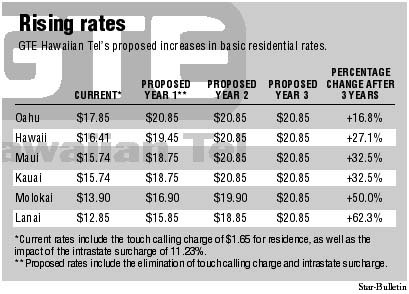

Prices will go up nearly 17 percent
By Rob Perez
on Oahu and up to 62 percent
on some other islands
Star-BulletinGTE Hawaiian Tel today proposed raising residential phone rates by nearly 17 percent on Oahu and between 27 percent and 62 percent on the neighbor islands.
At the same time, the company is seeking to slash the cost of a business line on Oahu by nearly 22 percent, raise the business rate by 26 percent to 84 percent on the neighbor islands and make permanent a temporary reduction in interisland phone charges started roughly two years ago.
The rebalancing of GTE's rates is designed to bring them more in line with the cost of providing the service -- a necessary step to foster more competition in Hawaii's telecom markets, according to GTE.
Because of the magnitude of the proposed jumps for residential customers on the neighbor islands, GTE wants to phase in those increases over three years, with all households eventually paying the same basic rate of $20.85.

"There was a really strong effort to try to minimize the impact on the neighbor islands," said Laura Matsuo, GTE's manager of regulatory and government affairs.GTE filed its proposed rates today with the state Public Utilities Commission, which must approve them before the rates can take effect. The commission typically takes months to evaluate such requests.
When the higher basic rates are combined with the lower interisland phone rates, the net effect to typical GTE residential customers will be small, especially for neighbor island residents who usually make more interisland calls, the company said.
For a typical Oahu customer, the monthly residential bill will rise $2.13 to $25.47, according to GTE. On Maui, the typical monthly bill will increase about $2.35 to $27.88 once the full increase is in effect. On the Big Island, the typical residential bill will rise $1.10 to $28.61 monthly, while a typical Kauai customer will see a jump of $1.66 to $28.76.
But those examples mask the actual impact most residents will see because they already are paying the lower interisland rates, albeit on a "temporary" basis. If the commission approves GTE's proposal, customers will see their bills increase largely by the amounts of the rises in basic charges.
The temporary, reduced interisland rates are scheduled to expire in August, but the company is expected to ask the commission to continue those rates pending a decision on today's request.
Today's filing is essentially a revision of a 1997 request to the commission that called for increasing basic rates nearly 38 percent for Oahu residents and by much steeper amounts for neighbor island households. But the two proposals aren't comparable because of differences in the two filings.
The 1997 proposal was criticized as unreasonable by then-state Consumer Advocate Chuck Totto.
GTE said that, like its earlier request, today's proposal isn't designed to generate additional revenue for GTE, but it adjusts rates to make them more accurately reflect the cost of delivering the service.